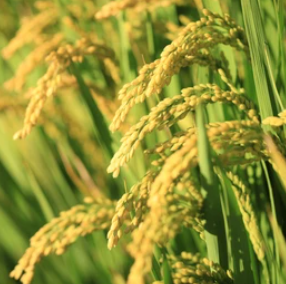Information report for OsIAA1
Gene Details
|

|
Functional Descriptions
- Indica) OsIAA1 cDNA as a monocot member of the Aux/IAA gene family.
- The predicted amino acid sequence of OsIAA1 corresponds to a protein of ca.
- Northern blot analysis revealed that the OsIAA1 transcript levels decrease in the excised coleoptile segments on auxin starvation, and the level is restored when auxin is supplemented; the increase in OsIAA1 transcript level was apparent within 15 to 30 min of auxin application.
- Auxin-induced OsIAA1 expression appears to be correlated with the elongation of excised coleoptile segments.
- In light-grown rice seedlings, OsIAA1 is preferentially expressed in roots and basal segment of the seedling, whereas in the etiolated rice seedlings, the OsIAA1 transcripts are most abundant in the coleoptile.
- A comparative analysis in light- and dark-grown seedling tissues indicates that the OsIAA1 transcript levels decrease on illumination.
- OsIAA1, an Aux/IAA cDNA from Rice, and Changes in Its Expression as Influenced by Auxin and Light.
- In addition, the OsIAA1-overexpression transgenic plants showed distinctive morphological changes such as decreased plant height and loose plant architecture.
- T-DNA insertion mutant of OsARF1 showed reduced sensitivity to BR treatment, resembling the phenotype of OsIAA1-overexpression plants.
- Over-expression of OsIAA1 in rice resulted in reduced inhibition of root elongation to auxin treatment, but increased sensitivity to 24-epiBL treatment.
- In addition, expression patterns of some genes responsive to brassinosteroid and auxin were changed in the OsIAA1-overexpression plants.
- These data suggested that OsIAA1 may play important roles in the cross-talk of auxin and brassinosteroid signaling pathways and plant morphogenesis.
- Characterization of OsIAA1 gene, a member of rice Aux/IAA family involved in auxin and brassinosteroid hormone responses and plant morphogenesis.
- Moreover, yeast two-hybrid and bimolecular fluorescence complementation assays showed that OsTIR1 and OsAFB2 interact with OsIAA1.
- This work focused on isolation and characterization of a member of Aux/IAA family in rice named OsIAA1.
- The results indicated that OsIAA1 was constitutively expressed in all the tissues and organs investigated.
- Protein interaction analysis suggested that OsIAA1 may act through interaction with OsARF1.
Functional Keywords
- iaa , height , BR , auxin , seedling , brassinosteroid , root , architecture
Literature and News
- Characterization of OsIAA1 gene, a member of rice Aux/IAA family involved in auxin and brassinosteroid hormone responses and plant morphogenesis . DOI: 10.1007/s11103-009-9474-1 ; PMID: 19266169
- OsIAA1, an Aux/IAA cDNA from rice, and changes in its expression as influenced by auxin and light . DOI: 10.1093/dnares/8.5.193 ; PMID: 11759839
- Ectopic overexpression of an AUXIN/INDOLE-3-ACETIC ACID (Aux/IAA) gene OsIAA4 in rice induces morphological changes and reduces responsiveness to Auxin . DOI: 10.3390/ijms140713645 ; PMID: 23812082
- Distinctive expression patterns and roles of the miRNA393/TIR1 homolog module in regulating flag leaf inclination and primary and crown root growth in rice (Oryza sativa) . DOI: 10.1111/j.1469-8137.2012.04248.x ; PMID: 22846038
- Functional analysis of auxin receptor OsTIR1/OsAFB family members in rice grain yield, tillering, plant height, root system, germination, and auxinic herbicide resistance . DOI: 10.1111/nph.17061 ; PMID: 33135782
- Rice EIL1 interacts with OsIAAs to regulate auxin biosynthesis mediated by the tryptophan aminotransferase MHZ10/OsTAR2 during root ethylene responses . DOI: 10.1093/plcell/koac250 ; PMID: 35972379
Gene Resources
- UniProt: Q5VRD1
- EMBL: AK060091, AK069242, AK100800
- AlphaFoldDB: Q5VRD1
- EnsemblPlants: Os01t0178500-02
- Gramene: Os01t0178500-02
- KEGG: dosa:Os01g0178500
- Orthologous matrix: LCAFEEM
- InterPro: IPR003311, IPR033389, IPR053793
- PANTHER: PTHR31734, PTHR31734:SF34
- SUPFAM: SSF54277
- PROSITE: PS51745
- Gene3D: 3.10.20.90
- OrthoDB: Q5VRD1
- SWISS-MODEL: Q5VRD1
- eggNOG: ENOG502RYMU
Sequences
cDNA Sequence
- >LOC_Os01g08320.1
ATTTTGCTTTGCTTTCTTTGCTTTCCTCTCCTCTCTCGCCGCCCACCTCGCCGTCGCCGCCGCCGCGAGGGCCAACGCCGGCGAAGTCCGCGAGCCGAAGCATCACACAGCTGCGCCAGCGATGTCGGTGGAGACGGAGCGGAGCTCCACGGAGTCGTCCGCCGCGTCGGGGCTCGACTTCGAGGACACCGCCCTCACCCTCCGCCTCCCGGGCTCCCTCGCCGCCGCCGCCGCACCTGACCCCGACCGCAAGCGCTCCTCCCCCTCCTCCTCCGACGCCGCCGACGCCGCAGACAACTCCTCCCCCCTCGCCGCCGCCGCCGATGCTCCCCCTGCTCCCAAGGCGAGGGTGGTGGGGTGGCCGCCGGTGAGGTCGTTCAGGAAGAACGCGCTGGCGGCCAAGTTCGTGAAGGTGGCCGTGGACGGCGCGCCGTACCTGCGCAAGGTGGACCTCGAGGCCTACTCCGGCTACGACCAGCTCCTCCGCGCGCTCCAGGACAAGTTCTTCTCCCACTTCACCATCCGGAAGTTCGCCGACGACGAGAGGAAGCTGGTGGACGCGGTGAACGGGACGGAGTACGTGCCGACGTACGAGGACAAGGACGGCGACTGGATGCTCGTCGGCGACGTCCCCTGGAAGATGTTTGTGGAAACTTGCCAGCGCCTTCGTCTCATGAAAAGCTCAGAGGCTGTCAACTTAGCACCAAGAGCCGCTCAATGAGGCATTCCCGGTGCCCATGACCGTGTGGTTGGATTGAAAGAAAGTGGAAGCTTTGCCCCGCCGATGTTCGCCCACGTGTGATATGAACATGTACAGTTGTCTCCTACTACTTTTGGTTCCTTGATGATGCTGAGTTGAGAAAAAGGTTGTAGTTTCGTTACTCGTCTGTAGTCTCTCCATATATAGATAATGAAGCACTGAAGCTTGAAATATACACCTACAGTTTGTCTCTTTATGAATAAGACCATATACGCAAAAAAACCGATGTTCTTTGCTGCGGCTCGCGTGTCGTCAGGCTATATGCAGTTTTTTGTCGCACCATAGGCGATGGACATCTCTGGCCTTATACTTTCGTAAAAATCTTATCATGTTAAGCGATGGTCTTGCTTTGGAGTTCATAGTTCTGTGCTCTATGATGTGCAATCAGCTTGGTGTTCATCTATATATAATCTTTTGCTGCTGTATTCTGGTTATTGTACTAAGTTGTAACTGACGAAATGATCTCTTGGATGTTAGTGTCTTCGCTGATTGATATGAGCTCGTATCTATTGCTGCTGCATTCTGGTTTCTGTAACGAACAAAATAGTTTGTTGGTGAGGCTGAAAAACGTTATTGGAATGTTCAGTGTTTTACTCTG
CDS Sequence
- >LOC_Os01g08320.1
ATGTCGGTGGAGACGGAGCGGAGCTCCACGGAGTCGTCCGCCGCGTCGGGGCTCGACTTCGAGGACACCGCCCTCACCCTCCGCCTCCCGGGCTCCCTCGCCGCCGCCGCCGCACCTGACCCCGACCGCAAGCGCTCCTCCCCCTCCTCCTCCGACGCCGCCGACGCCGCAGACAACTCCTCCCCCCTCGCCGCCGCCGCCGATGCTCCCCCTGCTCCCAAGGCGAGGGTGGTGGGGTGGCCGCCGGTGAGGTCGTTCAGGAAGAACGCGCTGGCGGCCAAGTTCGTGAAGGTGGCCGTGGACGGCGCGCCGTACCTGCGCAAGGTGGACCTCGAGGCCTACTCCGGCTACGACCAGCTCCTCCGCGCGCTCCAGGACAAGTTCTTCTCCCACTTCACCATCCGGAAGTTCGCCGACGACGAGAGGAAGCTGGTGGACGCGGTGAACGGGACGGAGTACGTGCCGACGTACGAGGACAAGGACGGCGACTGGATGCTCGTCGGCGACGTCCCCTGGAAGATGTTTGTGGAAACTTGCCAGCGCCTTCGTCTCATGAAAAGCTCAGAGGCTGTCAACTTAGCACCAAGAGCCGCTCAATGA
Protein Sequence
- >LOC_Os01g08320.1
MSVETERSSTESSAASGLDFEDTALTLRLPGSLAAAAAPDPDRKRSSPSSSDAADAADNSSPLAAAADAPPAPKARVVGWPPVRSFRKNALAAKFVKVAVDGAPYLRKVDLEAYSGYDQLLRALQDKFFSHFTIRKFADDERKLVDAVNGTEYVPTYEDKDGDWMLVGDVPWKMFVETCQRLRLMKSSEAVNLAPRAAQ*